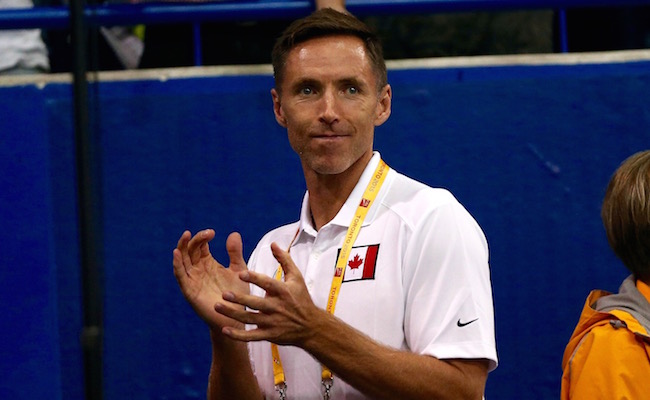
Canadian national team general manager Steve Nash has high hopes for his country’s basketball future. As for its more immediate present, the future Hall-of-Famer seems cautiously optimistic at best. Why? Despite a group of players more talented than any other our northern neighbor has ever assembled, Canada’s long-term strength is its short-term weakness: youth.
Reigning Rookie of the Year Andrew Wiggins and rising University of Kentucky freshman Jamal Murray highlight the country’s 16-man training camp roster for September’s FIBA Americas. A record 10 NBA players will take part in the tryouts, including 2013 No. 1 overall pick and Minnesota Timberwolves power forward Anthony Bennett, Boston Celtics big man Kelly Olynyk, Toronto Raptors guard Cory Joseph, Philadelphia 76ers sharp-shooter Nik Stauskas, and 7-foot-5 Sacramento Kings center Sim Bhullar, the first player of Indian descent to ever play in the league.
Wiggins and Murray, though, are Canada’s real stars – for today and tomorrow.
You already know about the Timberwolves’ high-flying wing. After a poor start to his inaugural pro campaign, Wiggins came on like gangbusters over the second half of 2014-2015, exhibiting the sky-high two-way potential that’s had so many forecasting his imminent superstardom for years to come. The next step in his development? Honing his handle and long-range jumper. And considering the immense strides he made during his rookie season, it seems only a matter of time until Wiggins boasts the extremely well-rounded game to match his otherworldly athleticism.
Murray isn’t quite a household name yet. The 18-year-old reclassified from the Class of 2016 to Class of 2015 after a dominant showing at April’s Nike Hoop Summit, subsequently committing to John Calipari and the Wildcats. Excitement surrounding the 6-foot-4 guard’s arrival in Lexington only reached a real fever pitch late last month, though, when he went bonkers late to lead Canada over USA Basketball’s C-team in the semifinals of the Pan-American games. Murray’s pro future is less certain than Wiggins’, but barring a disappointing freshman year, go ahead and pencil him in for the high lottery of next June’s draft. He’s an ideal lead guard for the modern NBA.

Looking past Wiggins and Murray, however, is where things get murky for Canada. Neither player is anywhere near his peak, and the supporting cast around them is similar on inexperience but lower on talent. Is coach Jay Triano’s young squad ready to win gold or silver next month and earn a spot in the 2016 Olympics? Nash isn’t sure.
“I expect us to qualify,” he told TSN in a radio interview last March, “but that is going to be a beast of a qualification.”
The United States qualified for Rio automatically by winning the 2012 games, and Brazil is afforded a spot as the host nation, too, despite its presence in the FIBA Americas field. Still, Canada’s chance at playing for gold is hardly ironclad; the tournament is stacked with quality sides like Argentina, Puerto Rico, Mexico, and the Dominican Republic.
“It’s an incredibly difficult group of guys that have played international basketball for a long time, played together,” Nash said of the FIBA competition. “And we’ve got a group that’s basically under 24, never played together and never played the international game in any real, meaningful capacity, especially collectively.”
Potential, Nash knows, is only just that. And while perhaps Wiggins, Olynyk, and Joseph can be counted on for consistently solid production, the same can’t be said for any other player on Canada’s roster. Will that be the case four years from now?
“The sky’s the limit, but I am by no stretch writing our name down to go to the Olympics,” Nash said. “I think our wheelhouse would be a medal-type team for the Olympics after this, 2020.”
With an older Wiggins and Murray leading an increasingly loaded roster, that’s definitely a fair expectation. Any of Canada’s tangible success before then will just be a sign of those bigger and better things to come.
[Via NBC Olympic Talk]






